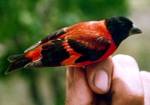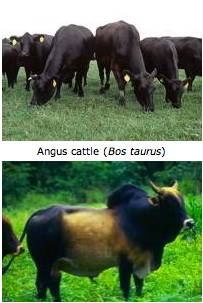On the Origins of New Forms of Life
2.6: Hybridization and Artificial Selection
(Continued from the previous page)

|
|
Canary. Image: FlyingBird |

|
|
Red Siskin. Image: Robbins, Braun, Finch |

|
| Red-factor canary. Image: Freegiampi |
Hybridization and Artificial Selection. Breeders commonly use artificial selection to produce new breeds from the variable offspring of hybrid crosses. In particular, they have long used a process, known as the backcross breeding method, to obtain new types of organisms.¹ The approach is to identify a type possessing some desirable trait and then to hybridize it with a "target stock" lacking the trait. If hybrids are obtained, the next step is to backcross them to the target stock in order to “introduce” the trait. Basically, the process is the following:
- Individuals from the target stock are crossed with some other stock having the trait;
- Hybrids with the trait are backcrossed to the target stock;
- Backcross progeny exhibiting the trait are selected for further backcrossing or bred among themselves;
- Selection over ensuing generations stabilizes the trait and eliminates other, undesirable traits that may be present (low fertility prominent among them);
- The new breed becomes stable when hybrid individuals of both sexes are sufficiently fertile to maintain the breed without further backcrossing.
The process is commonly used in producing new types of cage birds.² As Renzo Esuperanzi, the great breeder of fringillid finches, points out,
A famous example is Duncker's introduction of red coloration into canary stocks by crossing canary hens with the South American Red Siskin (Carduelis cucullata).⁴ Partially fertile male hybrid progeny were then backcrossed to canaries to introduce the trait. The same method has been used to transfer traits to the Red Siskin from the Eurasian Siskin (C. spinus) and from the Hooded Siskin (C. magellanica).⁵
These events are relatively recent, but the history of canary breeding stretches back to the sixteenth century, when they first became available in Europe. Thus, of canaries, an early naturalist, Johann Matthäus Bechstein (1757-1822), noted that
Were it not for such early records, one might suppose that the bewildering array of modern canary breeds had been produced simply by artificial selection of randomly occurring mutations without the use of hybridization to produce variation on which that selection could act. Similarly, the domestic chicken was recently shown to be of hybrid origin.⁷

|
|
Zebu (Bos indicus) Image: L. Mahin |
A variety of cattle breeds are derived from hybridization of European domestic cattle (Bos taurus) with the Zebu (B. indicus) followed by artificial selection of individuals with valuable traits. In the U.S., several new breeds have been produced from this cross, important ones including the Beefmaster (Zebu × Shorthorn and Hereford), Brangus (Zebu × Angus), Charbray (Zebu × Charolais), and Santa Gertrudis (Zebu × Shorthorn). In Africa, too, the Sanga breed, which is tolerant of the tsetse-fly-transmitted trypanosomes responsible for nagana, a disease deadly to non-African cattle, is derived from this cross.⁸
The Bengal, a popular new cat breed was produced in the 1980's by hybridizing the domestic cat (Felis catus) to the Asiatic leopard cat (F. bengalensis). This work was carried out primarily by Jean S. Mill of Millwood Bengals cattery in Covina, California. She began with partially fertile female backcross hybrids to domestic cat. After further backcrossing these hybrids to domestic, she obtained partially fertile males. The hybrids were then bred among themselves. Subsequent selection produced a cat with both the exotic coat of a leopard cat with the amiable disposition of a domestic.⁹
The Arkhar-Merino breed of sheep was produced between 1934 and 1950 at Kurmektinski experiment station of the Academy of Sciences of what was then the Kazakh SSR. It is derived from hybridization of domestic sheep (Ovis aries) with the Argali (O. ammon), which occurs in the mountains of western and central Asia, followed by a few generations of artificial selection. The intent was to develop a new breed that would combine the valuable qualities of the Merino with the Argali's tolerance of high altitudes.
The breeding process began when domestic 212 Merino ewes were inseminated with O. ammon semen (Rumjancev et al. 1935). Forty-three F₁ lambs were obtained. Isenžulov (1938) says 400 domestic ewes were then inseminated with sperm from F₁ rams. About 400 offspring were obtained in the following year (1937). In 1938, about 500 more second generation backcross offspring and later-generation hybrids were obtained. According to Isenžulov (1938),
Kushner and Kitaeva (1938a) found that the hybrids’ blood profile was superior to that of the domestic sheep parent with respect to suitability for breeding at high altitudes. Subsequent selection for desirable characteristics produced the stable new breed.10 NEXT PAGE >>
Notes (List of Works Cited):
1. Carver and Taliaferro (1992); Esuperanzi (2005: 302); Soliman (1992).
2. Colard, J.-C. (1992); De Faveri (1989); Natale and Pidalà (2004).
3. Esuperanzi (2005: 301-302). Translated by E. M. McCarthy. Original Spanish: "Buena parte de los híbridos, si no fuese porque a veces nos dan indicaciones acerca de la afinidad genética de las dos especies, solamente servirían para exhibirlos en los concursos y poco mas. Pero si los híbridos resultan ser fértiles el asunto ya cambia totalamente, porque se los puede emplear para crear una nueva especie intermedia entre las dos de partida o para trasladar una mutacion de una especie a otra."
4. Birkhead (2003); Duncker (1927a, 1927b, 1928, 1934).
5. Esuperanzi (2005).
6. Translated in Shuckard (1848: 270).
7. Eriksson et al. (2008).
8. Bradley et al. (1994, 1996); Epstein (1971); Frisch et al. (1997); Hanotte et al. (2000).
9. Internet: History of the Bengal Cat; textfiles.com/fun/purebred.ca.
10. See: ftp://ftp.fao.org/docrep/fao/009/ah759e/ah759e16.pdf.
Most shared on Macroevolution.net:
Human Origins: Are we hybrids?
On the Origins of New Forms of Life
Mammalian Hybrids
Cat-rabbit Hybrids: Fact or fiction?
Famous Biologists
Dog-cow Hybrids
Georges Cuvier: A Biography
Prothero: A Rebuttal
Branches of Biology
Dog-fox Hybrids